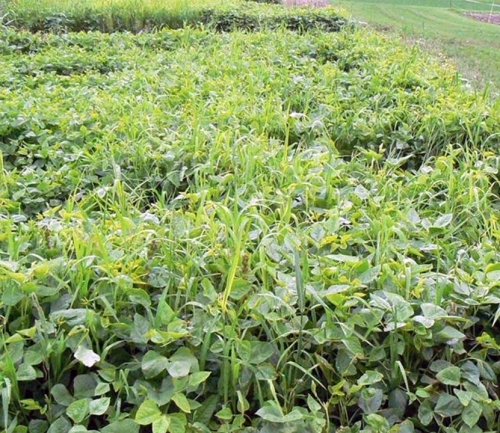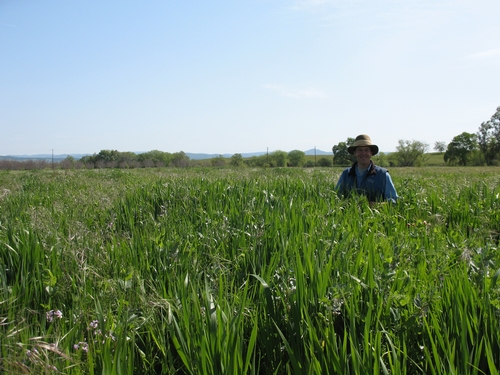Posts Tagged: cover crop
Summer Cover Crops - Creating a Drought Resilient Farm
In the current, extreme drought we are experiencing in Placer and Nevada counties, making decisions about row crop production can be challenging. Many of us already employ water efficient irrigation techniques like drip and mulch. But drought planning on the farm needs to be a combination of dealing with current situations while also preparing for the high probability of future, and potentially more severe drought conditions. One production decision addresses both: growing a summer cover crop. By growing a drought tolerant, summer cover crop you can productively fallow land during the dry months to conserve water. A summer cover crop will provide a large addition of soil organic matter which will increase the water retention in your soil during future growing seasons. Cover crops also add nutrition to the soil and decrease weed pressure.
There are a number of great summer cover crops to try. Sudangrass (Sorghum bicolor) is a great choice for the foothills during the heat of summer. It requires an initial watering at planting but can be dry farmed once established. Take caution before grazing ruminants on sudangrass as it contains highly toxic prussic acid (hydrocyanic acid.) Sudangrass has lower concentrations of prussic acid than its relative Sorghum or Sorghum-Sudangrass hybrids but it is still present in the leaves and roots of the plant. Hogs and chickens are less susceptible to prussic acid poisoning.
Another great choice for a summer cover crop is buckwheat (Fagopyrum esculentum.) Buckwheat will also grow in very dry conditions once established. It creates wonderful forage for bees and beneficial insects, is very fast growing, and helps make phosphorous more available in your soils (http://www.sarep.ucdavis.edu/covercrop/res/1994-1996/other/mini-review). Buckwheat's broad leaves and fast growth make it an ideal “smother crop” that will effectively shade out problematic weeds.
Cowpeas (Vigna unguiculata) is a good legume choice for the dry summer. They will add a lot of nitrogen to your soils and will also help suppress summer weeds. Both buckwheat and cowpeas can be used as forage crops as well.
Grow a bed of summer cover crop or grow an entire field. Try a mix of species or just one type of plant. Whichever choice you make, summer cover crops will help you farm productively under the constraints of drought.
For more information on summer cover crops, check out these resources:
http://asi.ucdavis.edu/sarep/database/covercrops
http://www.ces.ncsu.edu/hil/hil-37.html

cowpeas and japanese millet

sorgum sudangrass
It is time to start watering the crops
Is it irrigation or irritation? That is the question I always ask myself this time of the year. March was too wet and now April has been too dry so it is time to get the water flowing on the newly planted crops. I farm in what used to be a walnut orchard. The good and bad thing about using a former orchard is that it comes with the permanent sprinkler system that was used to irrigate the trees. The good part is that the pipes are all underground and there is a riser pipe every 60 feet. The trouble comes when the cover crop really gets to growing and pipes that used to be easily visible disappear in the lush growth of the vetch, bell beans and rye.
I like to mow my cover crop and then disc it in to get the crop to break down and open up the ground so that it can start to dry out so I can work it with my rototiller in a few weeks. I started the process listed above about 3 weeks ago and even though I am careful and I mark the sprinkler locations with tall poles I managed to hit a few. I always expect to hit a few and yet it never fails to annoy me.
This year in addition to fixing the pipes I broke with the disc and mower, I am lowering all the riser pipes to a few inches below grade. This is my latest attempt at finding an easy way to farm the rows that contain the pipes. With the pipes below grade I can now take my mower or tiller right over the top of the pipes without breaking them (I hope). In the past I have just ignored the pipe rows and grown my crops in the alleys between, but I learned that is not a good idea. Two really bad things happen. First the weeds go nuts and sprawl all over the place, and second all the gophers and field mice move in to avoid the tractors and tillers going back and forth in the alleys. The rodents then stage nightly sorties into the alleys to chew on everything in sight. Not this year! This year I have a new plan. Now all I have to do is fix the irritation system so the plan will work. Did I say “irritation?” I mean “irrigation.”
The next week promises to be hard. I will be spending a lot of time on my hands and knees cutting pipes and gluing on new fittings. I am sure I will be making about fifty trips to the hardware store to buy more parts, especially the one part that I must have but forgot to buy the last time I was at the store. I would rather do this work now and conquer my pest problem in the beginning than trying to figure out a solution at the height of the growing season when I am lucky to think about anything other than picking and planting.


